Procurement Strategy: Analyzing Derbyshire Fabrication Group's Needs
VerifiedAdded on 2023/05/30
|16
|4198
|113
Report
AI Summary
This report analyzes the procurement strategy of Derbyshire Fabrication Group, a company facing challenges in its current procurement practices. The analysis begins with an overview of the role of procurement in the global supply chain and then examines the shortcomings of Derbyshire's current strategy, including a lack of centralized business strategy and coordination between sites. The report proposes several strategic alternatives, such as Total Quality Management (TQM), centralized versus decentralized procurement, and chain-level strategies, discussing the advantages and disadvantages of each. The report then recommends a new viable procurement strategy, providing a justified rationale for the recommendation, and concludes with a summary of the key findings and recommendations. The report emphasizes the importance of strategic procurement in enhancing profitability and sustainability, especially in industries like aircraft fabrication where high-quality materials and efficient supply chain management are crucial.

Running head: PROCUREMENT STRATEGY AND SUSTAINABILITY
Procurement Strategy and Sustainability
Name of the Student
Name of the University
Author note
Procurement Strategy and Sustainability
Name of the Student
Name of the University
Author note
Paraphrase This Document
Need a fresh take? Get an instant paraphrase of this document with our AI Paraphraser

1
PROCUREMENT STRATEGY AND SUSTAINABILITY
Table of Contents
Introduction:....................................................................................................................................1
Role of procurement in global supply chain:...................................................................................1
Current procurement strategy of Derbyshire Fabrication Group:....................................................3
Lack of centralised business strategy:.........................................................................................3
Lack of coordination between the sites:......................................................................................4
Proposition of strategic procurement alternative strategies and a new viable strategy:..................4
Total Quality Management:.........................................................................................................5
Advantages of TQM:...............................................................................................................5
Disadvantage:..........................................................................................................................6
Centralised vs decentralized:...........................................................................................................6
Chain level strategy:........................................................................................................................7
COX matrix:....................................................................................................................................8
E-procurement:................................................................................................................................8
Krajlic Matrix:.................................................................................................................................8
Recommendation of best practice to be implemented:....................................................................9
Conclusion:......................................................................................................................................9
References:....................................................................................................................................10
PROCUREMENT STRATEGY AND SUSTAINABILITY
Table of Contents
Introduction:....................................................................................................................................1
Role of procurement in global supply chain:...................................................................................1
Current procurement strategy of Derbyshire Fabrication Group:....................................................3
Lack of centralised business strategy:.........................................................................................3
Lack of coordination between the sites:......................................................................................4
Proposition of strategic procurement alternative strategies and a new viable strategy:..................4
Total Quality Management:.........................................................................................................5
Advantages of TQM:...............................................................................................................5
Disadvantage:..........................................................................................................................6
Centralised vs decentralized:...........................................................................................................6
Chain level strategy:........................................................................................................................7
COX matrix:....................................................................................................................................8
E-procurement:................................................................................................................................8
Krajlic Matrix:.................................................................................................................................8
Recommendation of best practice to be implemented:....................................................................9
Conclusion:......................................................................................................................................9
References:....................................................................................................................................10
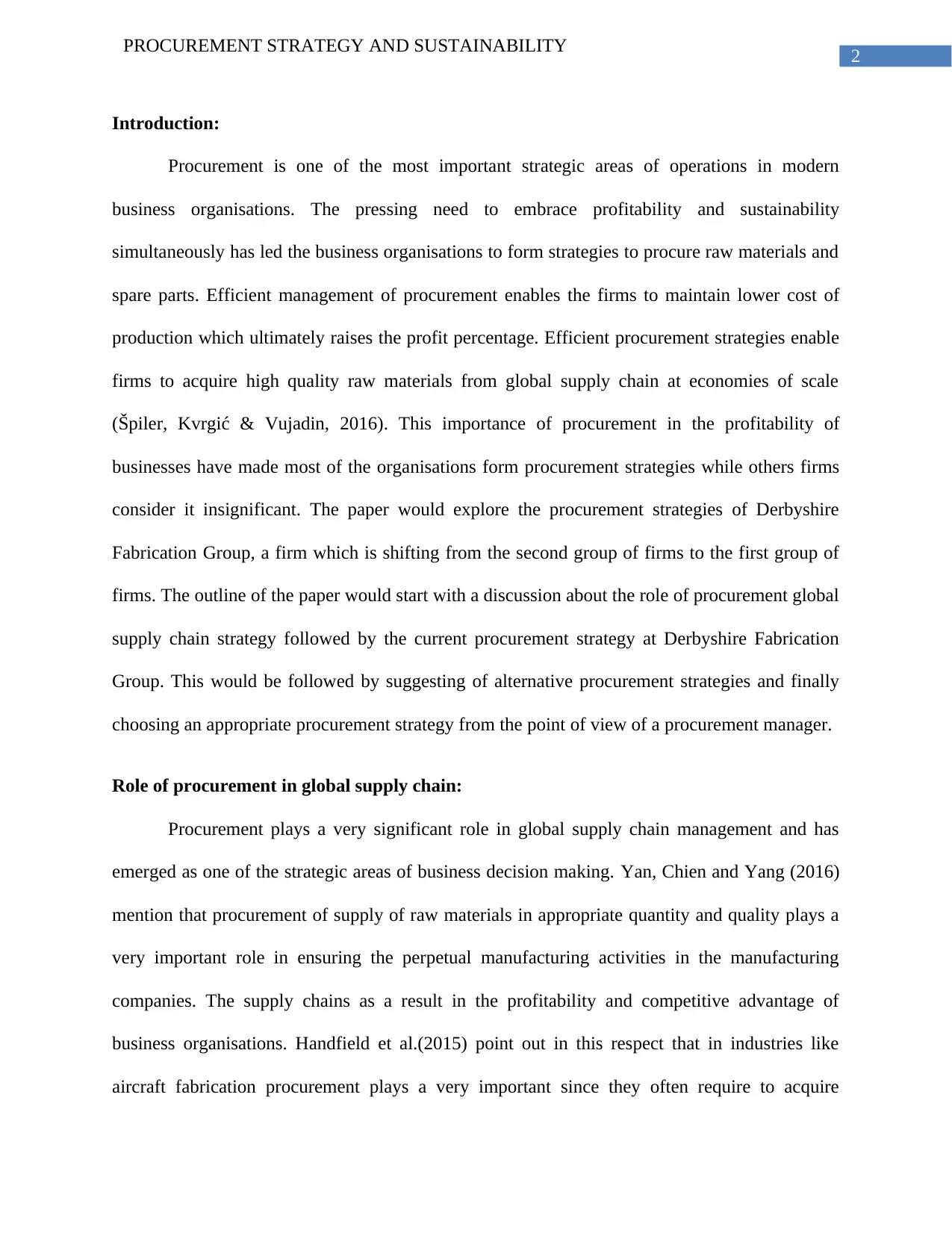
2
PROCUREMENT STRATEGY AND SUSTAINABILITY
Introduction:
Procurement is one of the most important strategic areas of operations in modern
business organisations. The pressing need to embrace profitability and sustainability
simultaneously has led the business organisations to form strategies to procure raw materials and
spare parts. Efficient management of procurement enables the firms to maintain lower cost of
production which ultimately raises the profit percentage. Efficient procurement strategies enable
firms to acquire high quality raw materials from global supply chain at economies of scale
(Špiler, Kvrgić & Vujadin, 2016). This importance of procurement in the profitability of
businesses have made most of the organisations form procurement strategies while others firms
consider it insignificant. The paper would explore the procurement strategies of Derbyshire
Fabrication Group, a firm which is shifting from the second group of firms to the first group of
firms. The outline of the paper would start with a discussion about the role of procurement global
supply chain strategy followed by the current procurement strategy at Derbyshire Fabrication
Group. This would be followed by suggesting of alternative procurement strategies and finally
choosing an appropriate procurement strategy from the point of view of a procurement manager.
Role of procurement in global supply chain:
Procurement plays a very significant role in global supply chain management and has
emerged as one of the strategic areas of business decision making. Yan, Chien and Yang (2016)
mention that procurement of supply of raw materials in appropriate quantity and quality plays a
very important role in ensuring the perpetual manufacturing activities in the manufacturing
companies. The supply chains as a result in the profitability and competitive advantage of
business organisations. Handfield et al.(2015) point out in this respect that in industries like
aircraft fabrication procurement plays a very important since they often require to acquire
PROCUREMENT STRATEGY AND SUSTAINABILITY
Introduction:
Procurement is one of the most important strategic areas of operations in modern
business organisations. The pressing need to embrace profitability and sustainability
simultaneously has led the business organisations to form strategies to procure raw materials and
spare parts. Efficient management of procurement enables the firms to maintain lower cost of
production which ultimately raises the profit percentage. Efficient procurement strategies enable
firms to acquire high quality raw materials from global supply chain at economies of scale
(Špiler, Kvrgić & Vujadin, 2016). This importance of procurement in the profitability of
businesses have made most of the organisations form procurement strategies while others firms
consider it insignificant. The paper would explore the procurement strategies of Derbyshire
Fabrication Group, a firm which is shifting from the second group of firms to the first group of
firms. The outline of the paper would start with a discussion about the role of procurement global
supply chain strategy followed by the current procurement strategy at Derbyshire Fabrication
Group. This would be followed by suggesting of alternative procurement strategies and finally
choosing an appropriate procurement strategy from the point of view of a procurement manager.
Role of procurement in global supply chain:
Procurement plays a very significant role in global supply chain management and has
emerged as one of the strategic areas of business decision making. Yan, Chien and Yang (2016)
mention that procurement of supply of raw materials in appropriate quantity and quality plays a
very important role in ensuring the perpetual manufacturing activities in the manufacturing
companies. The supply chains as a result in the profitability and competitive advantage of
business organisations. Handfield et al.(2015) point out in this respect that in industries like
aircraft fabrication procurement plays a very important since they often require to acquire
⊘ This is a preview!⊘
Do you want full access?
Subscribe today to unlock all pages.

Trusted by 1+ million students worldwide
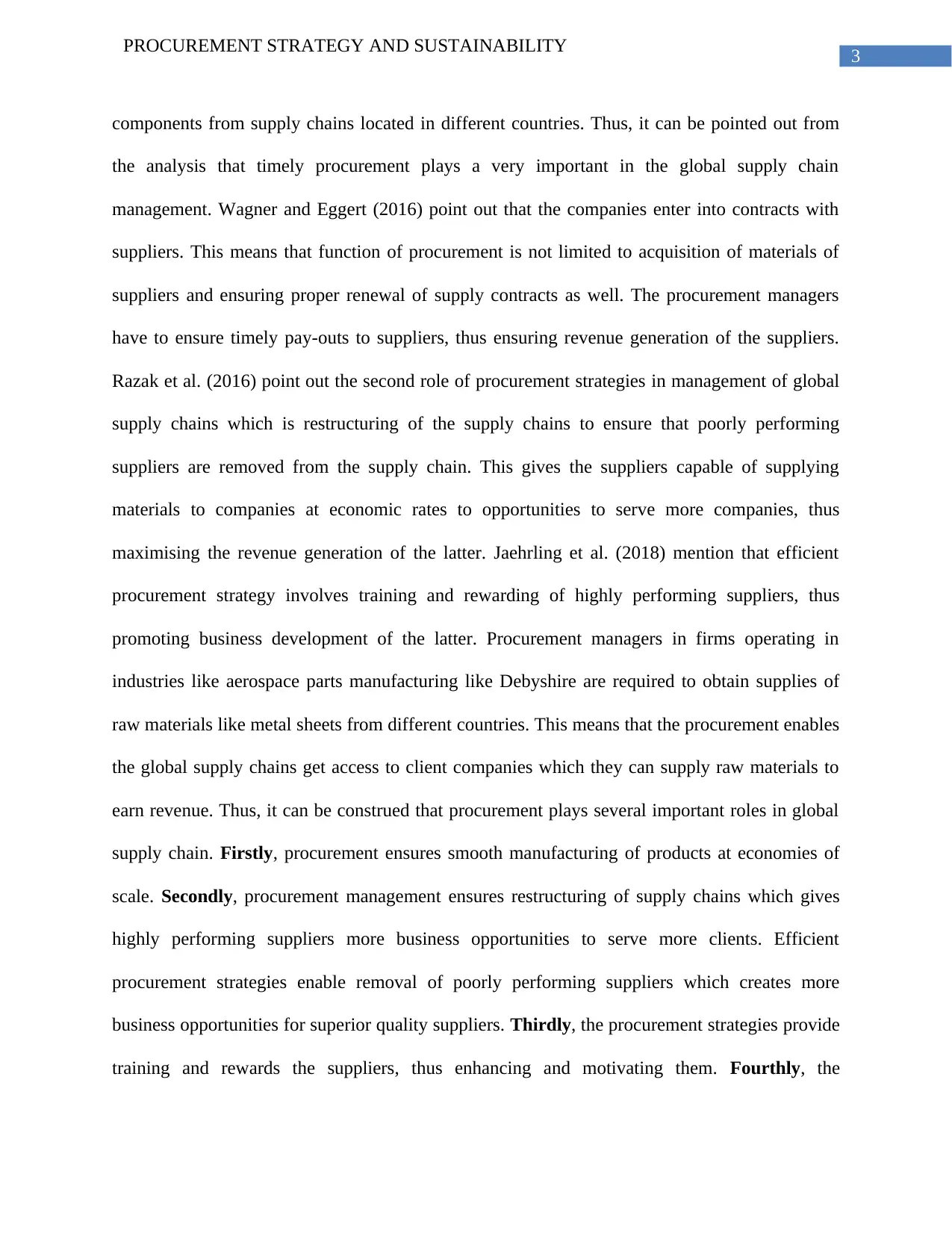
3
PROCUREMENT STRATEGY AND SUSTAINABILITY
components from supply chains located in different countries. Thus, it can be pointed out from
the analysis that timely procurement plays a very important in the global supply chain
management. Wagner and Eggert (2016) point out that the companies enter into contracts with
suppliers. This means that function of procurement is not limited to acquisition of materials of
suppliers and ensuring proper renewal of supply contracts as well. The procurement managers
have to ensure timely pay-outs to suppliers, thus ensuring revenue generation of the suppliers.
Razak et al. (2016) point out the second role of procurement strategies in management of global
supply chains which is restructuring of the supply chains to ensure that poorly performing
suppliers are removed from the supply chain. This gives the suppliers capable of supplying
materials to companies at economic rates to opportunities to serve more companies, thus
maximising the revenue generation of the latter. Jaehrling et al. (2018) mention that efficient
procurement strategy involves training and rewarding of highly performing suppliers, thus
promoting business development of the latter. Procurement managers in firms operating in
industries like aerospace parts manufacturing like Debyshire are required to obtain supplies of
raw materials like metal sheets from different countries. This means that the procurement enables
the global supply chains get access to client companies which they can supply raw materials to
earn revenue. Thus, it can be construed that procurement plays several important roles in global
supply chain. Firstly, procurement ensures smooth manufacturing of products at economies of
scale. Secondly, procurement management ensures restructuring of supply chains which gives
highly performing suppliers more business opportunities to serve more clients. Efficient
procurement strategies enable removal of poorly performing suppliers which creates more
business opportunities for superior quality suppliers. Thirdly, the procurement strategies provide
training and rewards the suppliers, thus enhancing and motivating them. Fourthly, the
PROCUREMENT STRATEGY AND SUSTAINABILITY
components from supply chains located in different countries. Thus, it can be pointed out from
the analysis that timely procurement plays a very important in the global supply chain
management. Wagner and Eggert (2016) point out that the companies enter into contracts with
suppliers. This means that function of procurement is not limited to acquisition of materials of
suppliers and ensuring proper renewal of supply contracts as well. The procurement managers
have to ensure timely pay-outs to suppliers, thus ensuring revenue generation of the suppliers.
Razak et al. (2016) point out the second role of procurement strategies in management of global
supply chains which is restructuring of the supply chains to ensure that poorly performing
suppliers are removed from the supply chain. This gives the suppliers capable of supplying
materials to companies at economic rates to opportunities to serve more companies, thus
maximising the revenue generation of the latter. Jaehrling et al. (2018) mention that efficient
procurement strategy involves training and rewarding of highly performing suppliers, thus
promoting business development of the latter. Procurement managers in firms operating in
industries like aerospace parts manufacturing like Debyshire are required to obtain supplies of
raw materials like metal sheets from different countries. This means that the procurement enables
the global supply chains get access to client companies which they can supply raw materials to
earn revenue. Thus, it can be construed that procurement plays several important roles in global
supply chain. Firstly, procurement ensures smooth manufacturing of products at economies of
scale. Secondly, procurement management ensures restructuring of supply chains which gives
highly performing suppliers more business opportunities to serve more clients. Efficient
procurement strategies enable removal of poorly performing suppliers which creates more
business opportunities for superior quality suppliers. Thirdly, the procurement strategies provide
training and rewards the suppliers, thus enhancing and motivating them. Fourthly, the
Paraphrase This Document
Need a fresh take? Get an instant paraphrase of this document with our AI Paraphraser
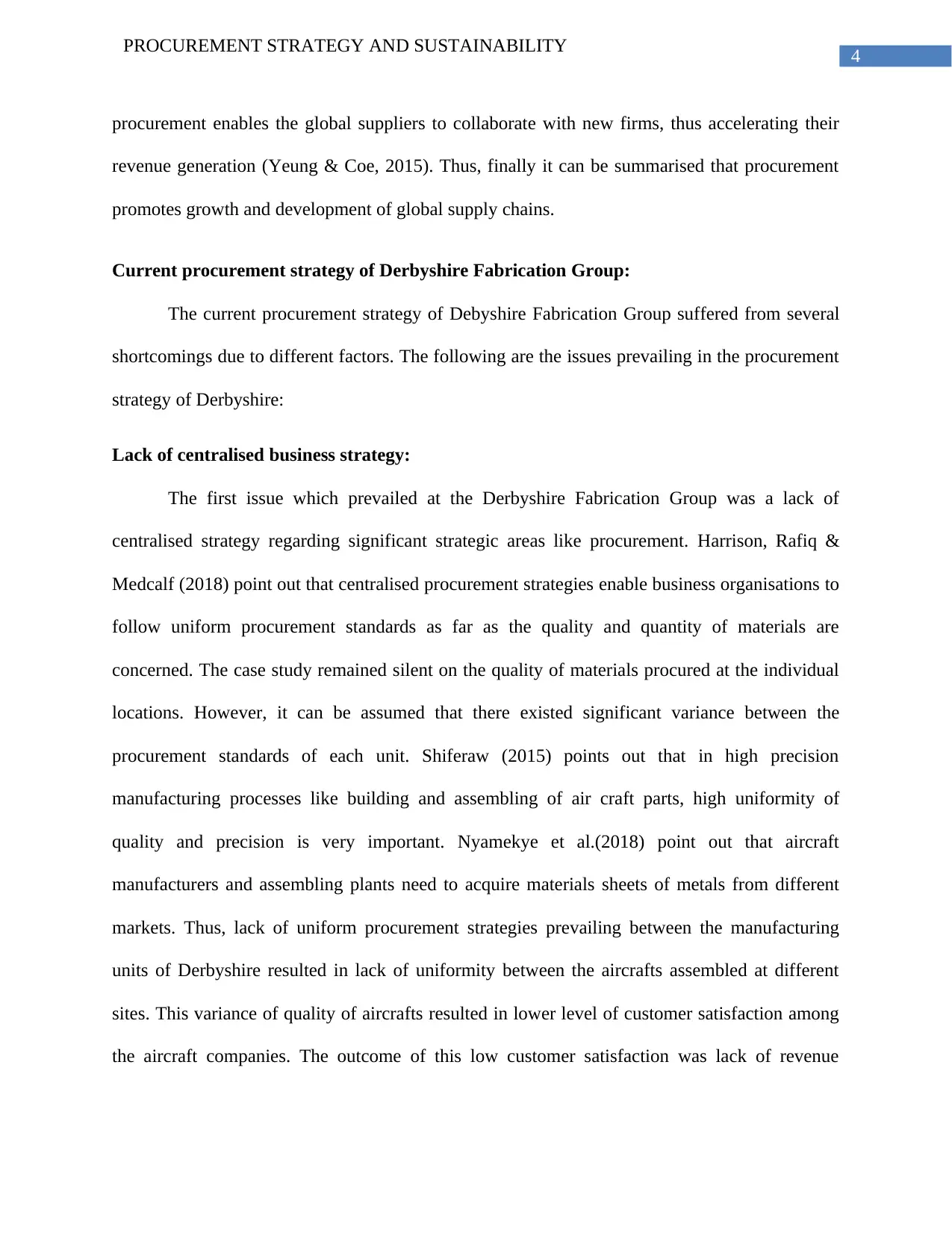
4
PROCUREMENT STRATEGY AND SUSTAINABILITY
procurement enables the global suppliers to collaborate with new firms, thus accelerating their
revenue generation (Yeung & Coe, 2015). Thus, finally it can be summarised that procurement
promotes growth and development of global supply chains.
Current procurement strategy of Derbyshire Fabrication Group:
The current procurement strategy of Debyshire Fabrication Group suffered from several
shortcomings due to different factors. The following are the issues prevailing in the procurement
strategy of Derbyshire:
Lack of centralised business strategy:
The first issue which prevailed at the Derbyshire Fabrication Group was a lack of
centralised strategy regarding significant strategic areas like procurement. Harrison, Rafiq &
Medcalf (2018) point out that centralised procurement strategies enable business organisations to
follow uniform procurement standards as far as the quality and quantity of materials are
concerned. The case study remained silent on the quality of materials procured at the individual
locations. However, it can be assumed that there existed significant variance between the
procurement standards of each unit. Shiferaw (2015) points out that in high precision
manufacturing processes like building and assembling of air craft parts, high uniformity of
quality and precision is very important. Nyamekye et al.(2018) point out that aircraft
manufacturers and assembling plants need to acquire materials sheets of metals from different
markets. Thus, lack of uniform procurement strategies prevailing between the manufacturing
units of Derbyshire resulted in lack of uniformity between the aircrafts assembled at different
sites. This variance of quality of aircrafts resulted in lower level of customer satisfaction among
the aircraft companies. The outcome of this low customer satisfaction was lack of revenue
PROCUREMENT STRATEGY AND SUSTAINABILITY
procurement enables the global suppliers to collaborate with new firms, thus accelerating their
revenue generation (Yeung & Coe, 2015). Thus, finally it can be summarised that procurement
promotes growth and development of global supply chains.
Current procurement strategy of Derbyshire Fabrication Group:
The current procurement strategy of Debyshire Fabrication Group suffered from several
shortcomings due to different factors. The following are the issues prevailing in the procurement
strategy of Derbyshire:
Lack of centralised business strategy:
The first issue which prevailed at the Derbyshire Fabrication Group was a lack of
centralised strategy regarding significant strategic areas like procurement. Harrison, Rafiq &
Medcalf (2018) point out that centralised procurement strategies enable business organisations to
follow uniform procurement standards as far as the quality and quantity of materials are
concerned. The case study remained silent on the quality of materials procured at the individual
locations. However, it can be assumed that there existed significant variance between the
procurement standards of each unit. Shiferaw (2015) points out that in high precision
manufacturing processes like building and assembling of air craft parts, high uniformity of
quality and precision is very important. Nyamekye et al.(2018) point out that aircraft
manufacturers and assembling plants need to acquire materials sheets of metals from different
markets. Thus, lack of uniform procurement strategies prevailing between the manufacturing
units of Derbyshire resulted in lack of uniformity between the aircrafts assembled at different
sites. This variance of quality of aircrafts resulted in lower level of customer satisfaction among
the aircraft companies. The outcome of this low customer satisfaction was lack of revenue
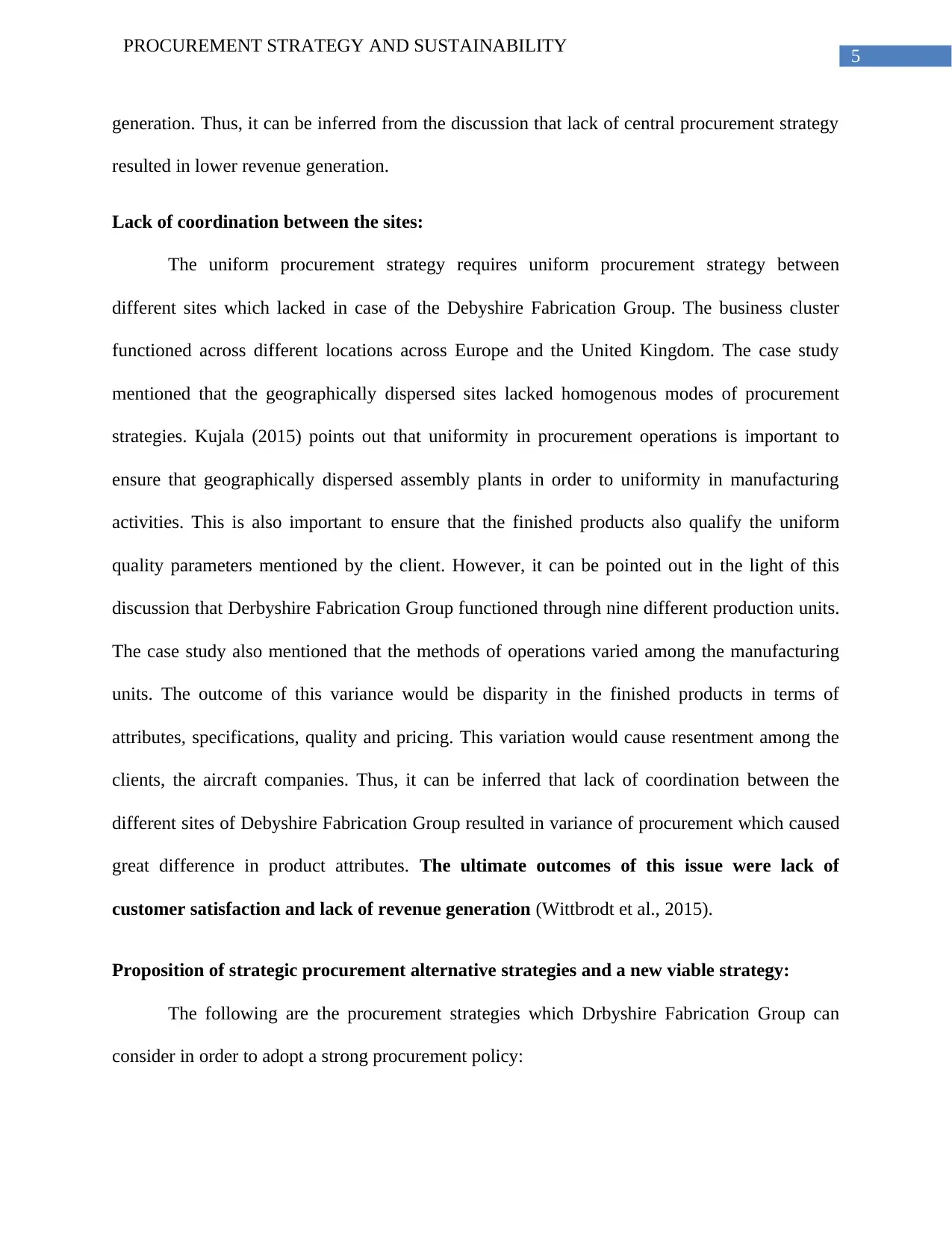
5
PROCUREMENT STRATEGY AND SUSTAINABILITY
generation. Thus, it can be inferred from the discussion that lack of central procurement strategy
resulted in lower revenue generation.
Lack of coordination between the sites:
The uniform procurement strategy requires uniform procurement strategy between
different sites which lacked in case of the Debyshire Fabrication Group. The business cluster
functioned across different locations across Europe and the United Kingdom. The case study
mentioned that the geographically dispersed sites lacked homogenous modes of procurement
strategies. Kujala (2015) points out that uniformity in procurement operations is important to
ensure that geographically dispersed assembly plants in order to uniformity in manufacturing
activities. This is also important to ensure that the finished products also qualify the uniform
quality parameters mentioned by the client. However, it can be pointed out in the light of this
discussion that Derbyshire Fabrication Group functioned through nine different production units.
The case study also mentioned that the methods of operations varied among the manufacturing
units. The outcome of this variance would be disparity in the finished products in terms of
attributes, specifications, quality and pricing. This variation would cause resentment among the
clients, the aircraft companies. Thus, it can be inferred that lack of coordination between the
different sites of Debyshire Fabrication Group resulted in variance of procurement which caused
great difference in product attributes. The ultimate outcomes of this issue were lack of
customer satisfaction and lack of revenue generation (Wittbrodt et al., 2015).
Proposition of strategic procurement alternative strategies and a new viable strategy:
The following are the procurement strategies which Drbyshire Fabrication Group can
consider in order to adopt a strong procurement policy:
PROCUREMENT STRATEGY AND SUSTAINABILITY
generation. Thus, it can be inferred from the discussion that lack of central procurement strategy
resulted in lower revenue generation.
Lack of coordination between the sites:
The uniform procurement strategy requires uniform procurement strategy between
different sites which lacked in case of the Debyshire Fabrication Group. The business cluster
functioned across different locations across Europe and the United Kingdom. The case study
mentioned that the geographically dispersed sites lacked homogenous modes of procurement
strategies. Kujala (2015) points out that uniformity in procurement operations is important to
ensure that geographically dispersed assembly plants in order to uniformity in manufacturing
activities. This is also important to ensure that the finished products also qualify the uniform
quality parameters mentioned by the client. However, it can be pointed out in the light of this
discussion that Derbyshire Fabrication Group functioned through nine different production units.
The case study also mentioned that the methods of operations varied among the manufacturing
units. The outcome of this variance would be disparity in the finished products in terms of
attributes, specifications, quality and pricing. This variation would cause resentment among the
clients, the aircraft companies. Thus, it can be inferred that lack of coordination between the
different sites of Debyshire Fabrication Group resulted in variance of procurement which caused
great difference in product attributes. The ultimate outcomes of this issue were lack of
customer satisfaction and lack of revenue generation (Wittbrodt et al., 2015).
Proposition of strategic procurement alternative strategies and a new viable strategy:
The following are the procurement strategies which Drbyshire Fabrication Group can
consider in order to adopt a strong procurement policy:
⊘ This is a preview!⊘
Do you want full access?
Subscribe today to unlock all pages.

Trusted by 1+ million students worldwide
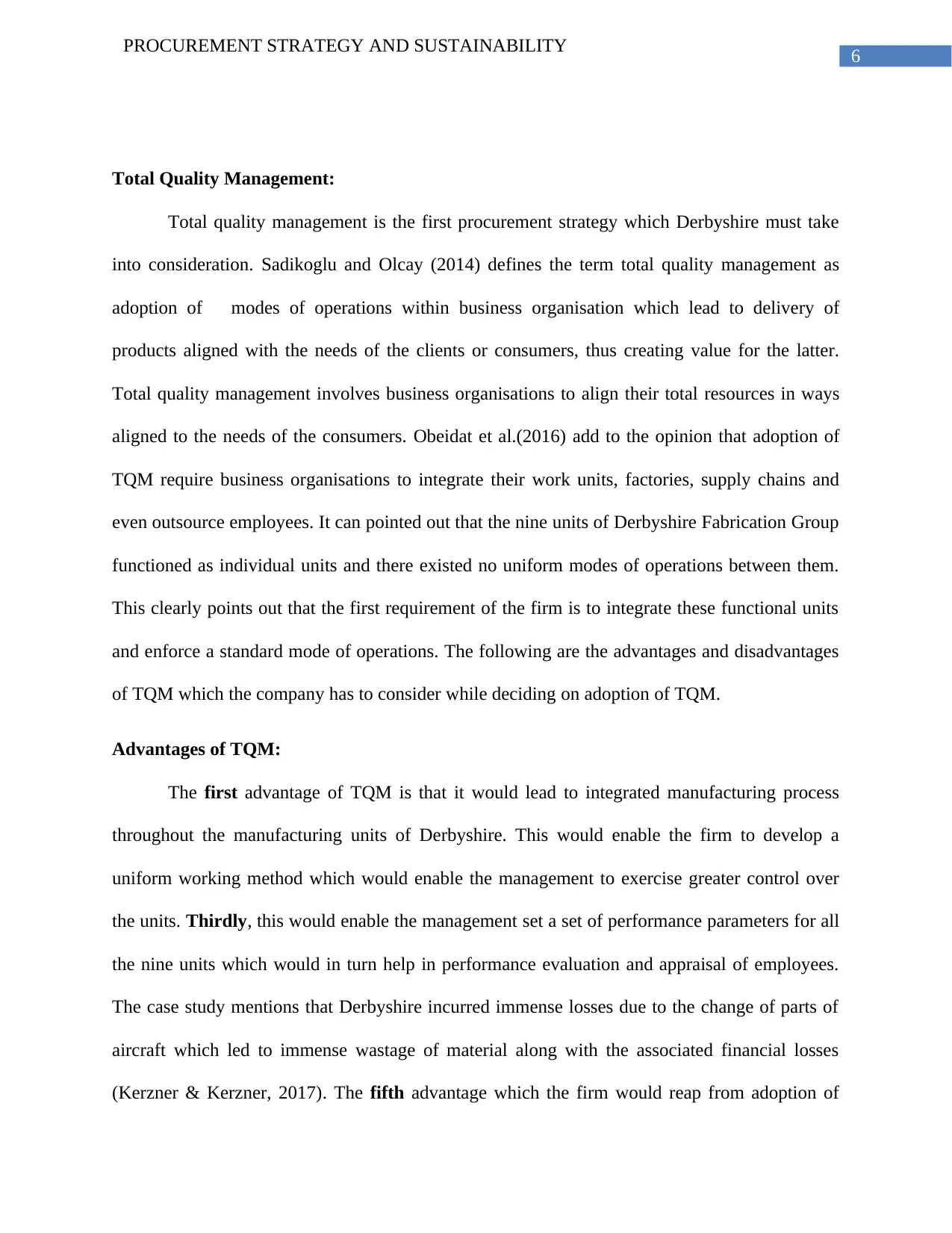
6
PROCUREMENT STRATEGY AND SUSTAINABILITY
Total Quality Management:
Total quality management is the first procurement strategy which Derbyshire must take
into consideration. Sadikoglu and Olcay (2014) defines the term total quality management as
adoption of modes of operations within business organisation which lead to delivery of
products aligned with the needs of the clients or consumers, thus creating value for the latter.
Total quality management involves business organisations to align their total resources in ways
aligned to the needs of the consumers. Obeidat et al.(2016) add to the opinion that adoption of
TQM require business organisations to integrate their work units, factories, supply chains and
even outsource employees. It can pointed out that the nine units of Derbyshire Fabrication Group
functioned as individual units and there existed no uniform modes of operations between them.
This clearly points out that the first requirement of the firm is to integrate these functional units
and enforce a standard mode of operations. The following are the advantages and disadvantages
of TQM which the company has to consider while deciding on adoption of TQM.
Advantages of TQM:
The first advantage of TQM is that it would lead to integrated manufacturing process
throughout the manufacturing units of Derbyshire. This would enable the firm to develop a
uniform working method which would enable the management to exercise greater control over
the units. Thirdly, this would enable the management set a set of performance parameters for all
the nine units which would in turn help in performance evaluation and appraisal of employees.
The case study mentions that Derbyshire incurred immense losses due to the change of parts of
aircraft which led to immense wastage of material along with the associated financial losses
(Kerzner & Kerzner, 2017). The fifth advantage which the firm would reap from adoption of
PROCUREMENT STRATEGY AND SUSTAINABILITY
Total Quality Management:
Total quality management is the first procurement strategy which Derbyshire must take
into consideration. Sadikoglu and Olcay (2014) defines the term total quality management as
adoption of modes of operations within business organisation which lead to delivery of
products aligned with the needs of the clients or consumers, thus creating value for the latter.
Total quality management involves business organisations to align their total resources in ways
aligned to the needs of the consumers. Obeidat et al.(2016) add to the opinion that adoption of
TQM require business organisations to integrate their work units, factories, supply chains and
even outsource employees. It can pointed out that the nine units of Derbyshire Fabrication Group
functioned as individual units and there existed no uniform modes of operations between them.
This clearly points out that the first requirement of the firm is to integrate these functional units
and enforce a standard mode of operations. The following are the advantages and disadvantages
of TQM which the company has to consider while deciding on adoption of TQM.
Advantages of TQM:
The first advantage of TQM is that it would lead to integrated manufacturing process
throughout the manufacturing units of Derbyshire. This would enable the firm to develop a
uniform working method which would enable the management to exercise greater control over
the units. Thirdly, this would enable the management set a set of performance parameters for all
the nine units which would in turn help in performance evaluation and appraisal of employees.
The case study mentions that Derbyshire incurred immense losses due to the change of parts of
aircraft which led to immense wastage of material along with the associated financial losses
(Kerzner & Kerzner, 2017). The fifth advantage which the firm would reap from adoption of
Paraphrase This Document
Need a fresh take? Get an instant paraphrase of this document with our AI Paraphraser
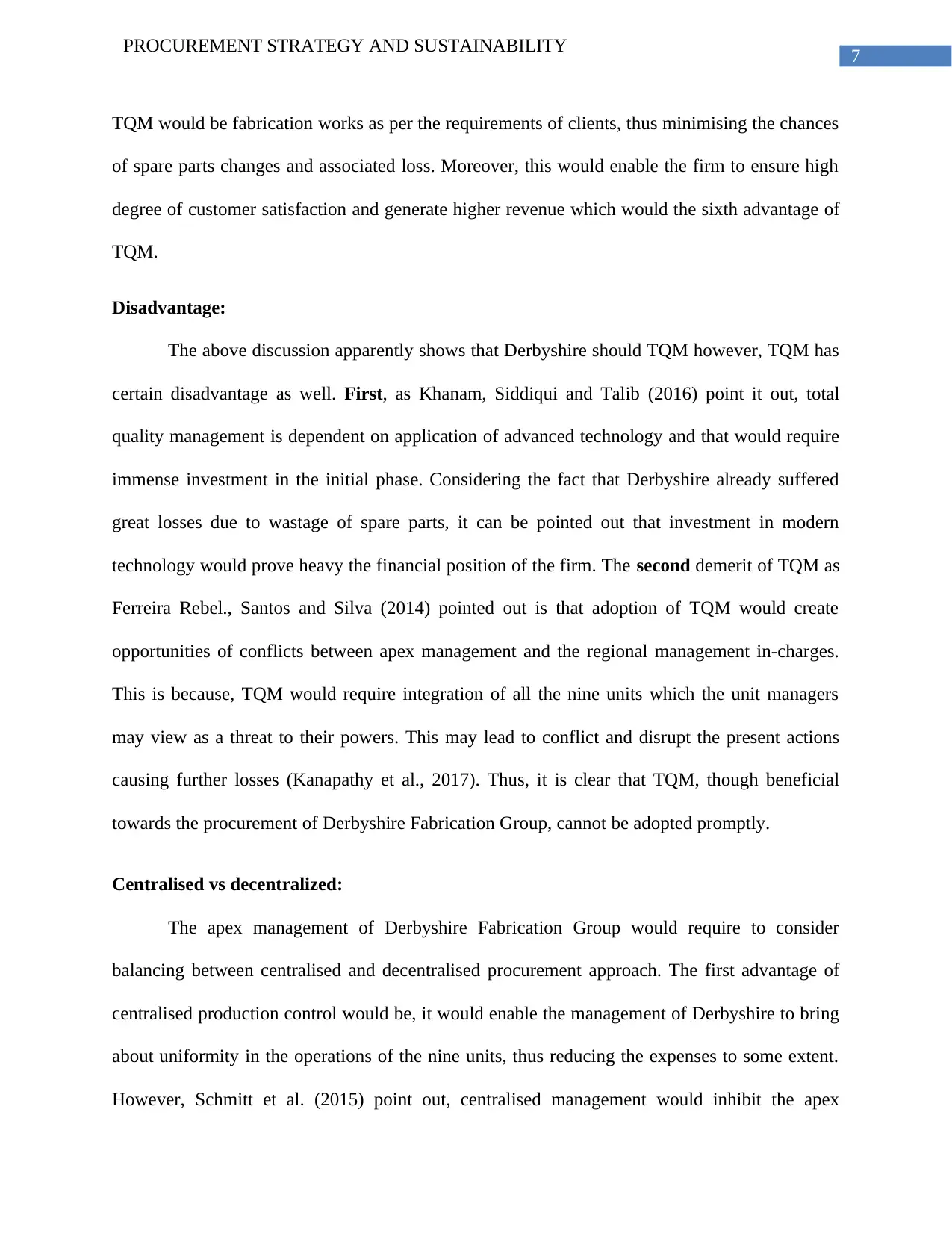
7
PROCUREMENT STRATEGY AND SUSTAINABILITY
TQM would be fabrication works as per the requirements of clients, thus minimising the chances
of spare parts changes and associated loss. Moreover, this would enable the firm to ensure high
degree of customer satisfaction and generate higher revenue which would the sixth advantage of
TQM.
Disadvantage:
The above discussion apparently shows that Derbyshire should TQM however, TQM has
certain disadvantage as well. First, as Khanam, Siddiqui and Talib (2016) point it out, total
quality management is dependent on application of advanced technology and that would require
immense investment in the initial phase. Considering the fact that Derbyshire already suffered
great losses due to wastage of spare parts, it can be pointed out that investment in modern
technology would prove heavy the financial position of the firm. The second demerit of TQM as
Ferreira Rebel., Santos and Silva (2014) pointed out is that adoption of TQM would create
opportunities of conflicts between apex management and the regional management in-charges.
This is because, TQM would require integration of all the nine units which the unit managers
may view as a threat to their powers. This may lead to conflict and disrupt the present actions
causing further losses (Kanapathy et al., 2017). Thus, it is clear that TQM, though beneficial
towards the procurement of Derbyshire Fabrication Group, cannot be adopted promptly.
Centralised vs decentralized:
The apex management of Derbyshire Fabrication Group would require to consider
balancing between centralised and decentralised procurement approach. The first advantage of
centralised production control would be, it would enable the management of Derbyshire to bring
about uniformity in the operations of the nine units, thus reducing the expenses to some extent.
However, Schmitt et al. (2015) point out, centralised management would inhibit the apex
PROCUREMENT STRATEGY AND SUSTAINABILITY
TQM would be fabrication works as per the requirements of clients, thus minimising the chances
of spare parts changes and associated loss. Moreover, this would enable the firm to ensure high
degree of customer satisfaction and generate higher revenue which would the sixth advantage of
TQM.
Disadvantage:
The above discussion apparently shows that Derbyshire should TQM however, TQM has
certain disadvantage as well. First, as Khanam, Siddiqui and Talib (2016) point it out, total
quality management is dependent on application of advanced technology and that would require
immense investment in the initial phase. Considering the fact that Derbyshire already suffered
great losses due to wastage of spare parts, it can be pointed out that investment in modern
technology would prove heavy the financial position of the firm. The second demerit of TQM as
Ferreira Rebel., Santos and Silva (2014) pointed out is that adoption of TQM would create
opportunities of conflicts between apex management and the regional management in-charges.
This is because, TQM would require integration of all the nine units which the unit managers
may view as a threat to their powers. This may lead to conflict and disrupt the present actions
causing further losses (Kanapathy et al., 2017). Thus, it is clear that TQM, though beneficial
towards the procurement of Derbyshire Fabrication Group, cannot be adopted promptly.
Centralised vs decentralized:
The apex management of Derbyshire Fabrication Group would require to consider
balancing between centralised and decentralised procurement approach. The first advantage of
centralised production control would be, it would enable the management of Derbyshire to bring
about uniformity in the operations of the nine units, thus reducing the expenses to some extent.
However, Schmitt et al. (2015) point out, centralised management would inhibit the apex
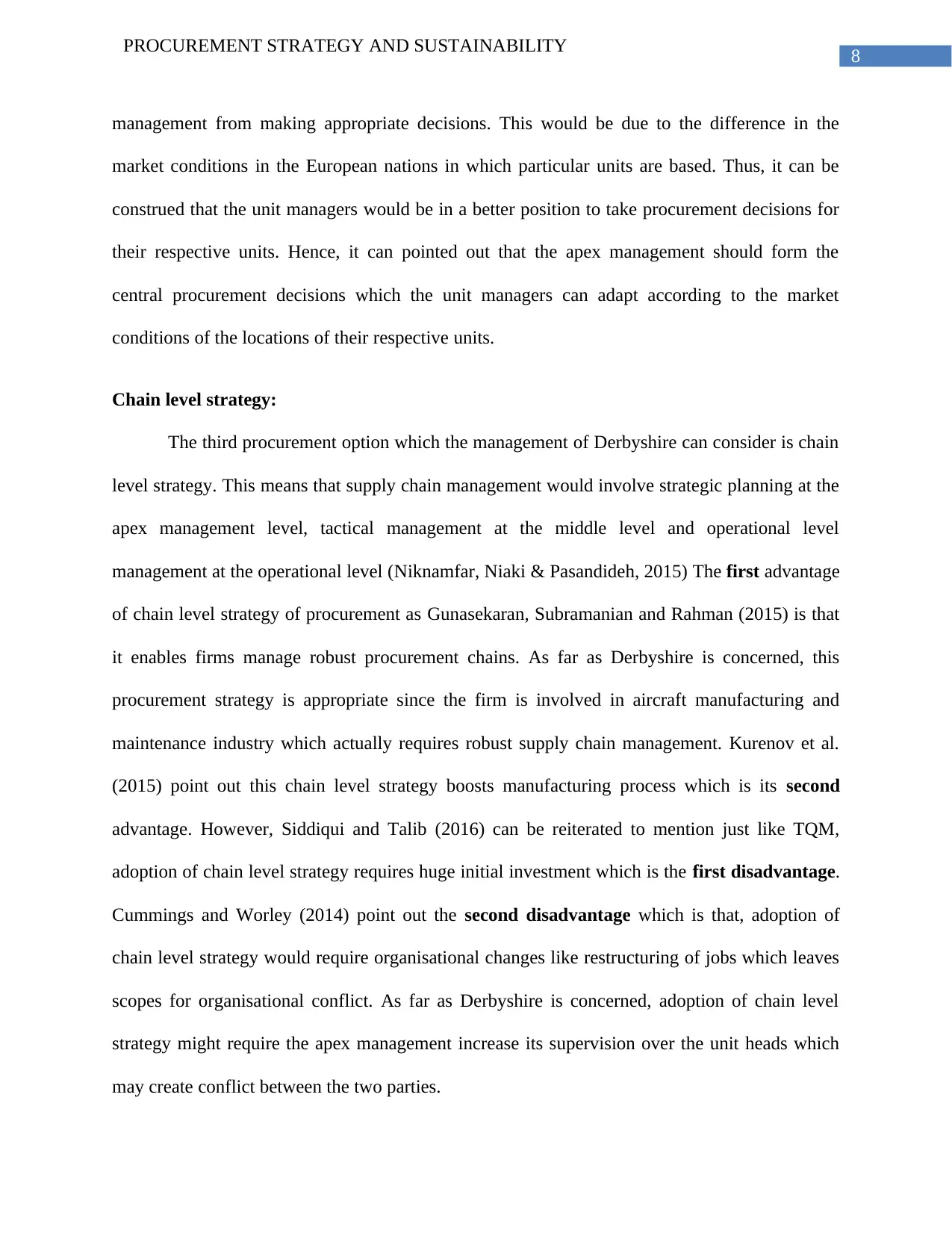
8
PROCUREMENT STRATEGY AND SUSTAINABILITY
management from making appropriate decisions. This would be due to the difference in the
market conditions in the European nations in which particular units are based. Thus, it can be
construed that the unit managers would be in a better position to take procurement decisions for
their respective units. Hence, it can pointed out that the apex management should form the
central procurement decisions which the unit managers can adapt according to the market
conditions of the locations of their respective units.
Chain level strategy:
The third procurement option which the management of Derbyshire can consider is chain
level strategy. This means that supply chain management would involve strategic planning at the
apex management level, tactical management at the middle level and operational level
management at the operational level (Niknamfar, Niaki & Pasandideh, 2015) The first advantage
of chain level strategy of procurement as Gunasekaran, Subramanian and Rahman (2015) is that
it enables firms manage robust procurement chains. As far as Derbyshire is concerned, this
procurement strategy is appropriate since the firm is involved in aircraft manufacturing and
maintenance industry which actually requires robust supply chain management. Kurenov et al.
(2015) point out this chain level strategy boosts manufacturing process which is its second
advantage. However, Siddiqui and Talib (2016) can be reiterated to mention just like TQM,
adoption of chain level strategy requires huge initial investment which is the first disadvantage.
Cummings and Worley (2014) point out the second disadvantage which is that, adoption of
chain level strategy would require organisational changes like restructuring of jobs which leaves
scopes for organisational conflict. As far as Derbyshire is concerned, adoption of chain level
strategy might require the apex management increase its supervision over the unit heads which
may create conflict between the two parties.
PROCUREMENT STRATEGY AND SUSTAINABILITY
management from making appropriate decisions. This would be due to the difference in the
market conditions in the European nations in which particular units are based. Thus, it can be
construed that the unit managers would be in a better position to take procurement decisions for
their respective units. Hence, it can pointed out that the apex management should form the
central procurement decisions which the unit managers can adapt according to the market
conditions of the locations of their respective units.
Chain level strategy:
The third procurement option which the management of Derbyshire can consider is chain
level strategy. This means that supply chain management would involve strategic planning at the
apex management level, tactical management at the middle level and operational level
management at the operational level (Niknamfar, Niaki & Pasandideh, 2015) The first advantage
of chain level strategy of procurement as Gunasekaran, Subramanian and Rahman (2015) is that
it enables firms manage robust procurement chains. As far as Derbyshire is concerned, this
procurement strategy is appropriate since the firm is involved in aircraft manufacturing and
maintenance industry which actually requires robust supply chain management. Kurenov et al.
(2015) point out this chain level strategy boosts manufacturing process which is its second
advantage. However, Siddiqui and Talib (2016) can be reiterated to mention just like TQM,
adoption of chain level strategy requires huge initial investment which is the first disadvantage.
Cummings and Worley (2014) point out the second disadvantage which is that, adoption of
chain level strategy would require organisational changes like restructuring of jobs which leaves
scopes for organisational conflict. As far as Derbyshire is concerned, adoption of chain level
strategy might require the apex management increase its supervision over the unit heads which
may create conflict between the two parties.
⊘ This is a preview!⊘
Do you want full access?
Subscribe today to unlock all pages.

Trusted by 1+ million students worldwide
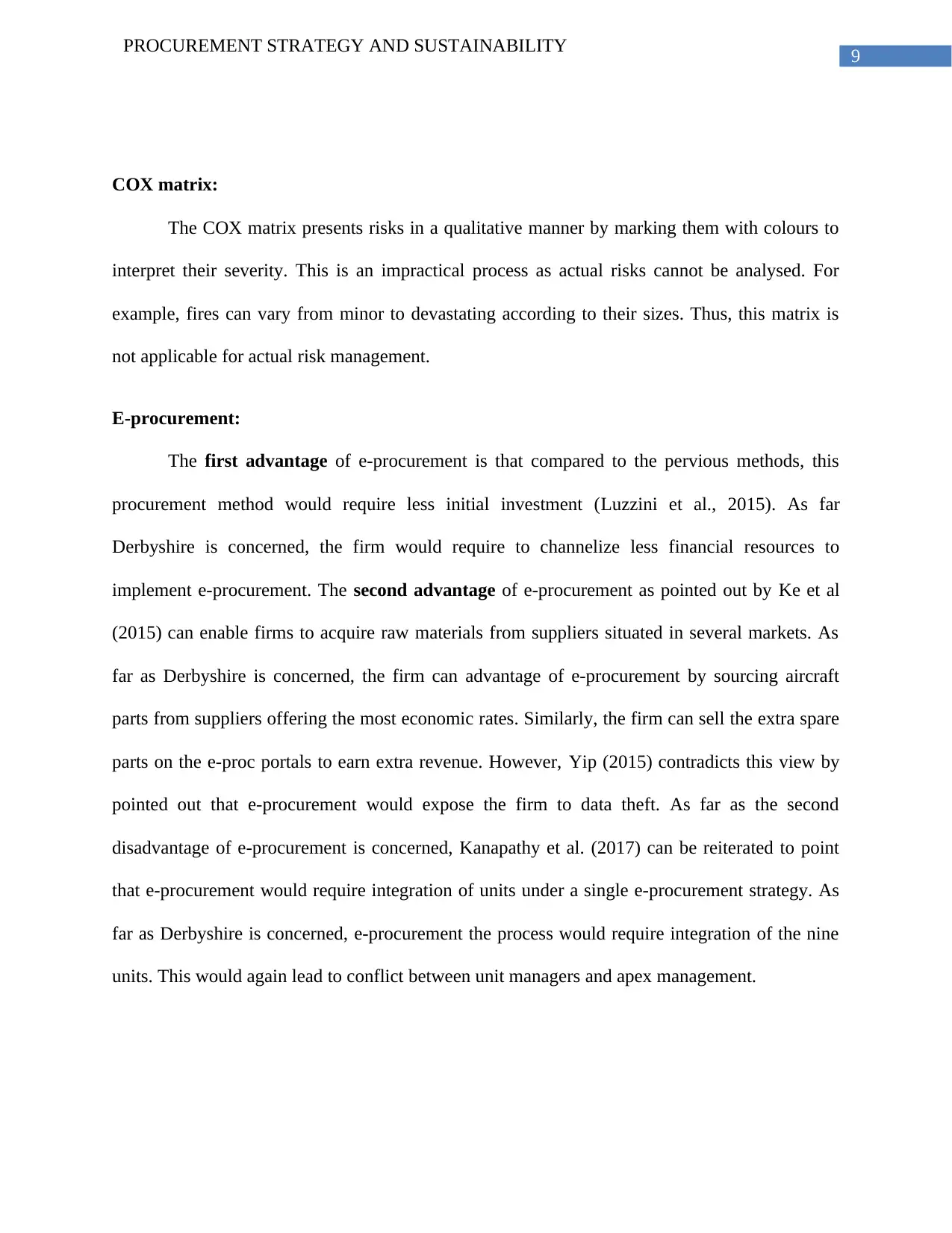
9
PROCUREMENT STRATEGY AND SUSTAINABILITY
COX matrix:
The COX matrix presents risks in a qualitative manner by marking them with colours to
interpret their severity. This is an impractical process as actual risks cannot be analysed. For
example, fires can vary from minor to devastating according to their sizes. Thus, this matrix is
not applicable for actual risk management.
E-procurement:
The first advantage of e-procurement is that compared to the pervious methods, this
procurement method would require less initial investment (Luzzini et al., 2015). As far
Derbyshire is concerned, the firm would require to channelize less financial resources to
implement e-procurement. The second advantage of e-procurement as pointed out by Ke et al
(2015) can enable firms to acquire raw materials from suppliers situated in several markets. As
far as Derbyshire is concerned, the firm can advantage of e-procurement by sourcing aircraft
parts from suppliers offering the most economic rates. Similarly, the firm can sell the extra spare
parts on the e-proc portals to earn extra revenue. However, Yip (2015) contradicts this view by
pointed out that e-procurement would expose the firm to data theft. As far as the second
disadvantage of e-procurement is concerned, Kanapathy et al. (2017) can be reiterated to point
that e-procurement would require integration of units under a single e-procurement strategy. As
far as Derbyshire is concerned, e-procurement the process would require integration of the nine
units. This would again lead to conflict between unit managers and apex management.
PROCUREMENT STRATEGY AND SUSTAINABILITY
COX matrix:
The COX matrix presents risks in a qualitative manner by marking them with colours to
interpret their severity. This is an impractical process as actual risks cannot be analysed. For
example, fires can vary from minor to devastating according to their sizes. Thus, this matrix is
not applicable for actual risk management.
E-procurement:
The first advantage of e-procurement is that compared to the pervious methods, this
procurement method would require less initial investment (Luzzini et al., 2015). As far
Derbyshire is concerned, the firm would require to channelize less financial resources to
implement e-procurement. The second advantage of e-procurement as pointed out by Ke et al
(2015) can enable firms to acquire raw materials from suppliers situated in several markets. As
far as Derbyshire is concerned, the firm can advantage of e-procurement by sourcing aircraft
parts from suppliers offering the most economic rates. Similarly, the firm can sell the extra spare
parts on the e-proc portals to earn extra revenue. However, Yip (2015) contradicts this view by
pointed out that e-procurement would expose the firm to data theft. As far as the second
disadvantage of e-procurement is concerned, Kanapathy et al. (2017) can be reiterated to point
that e-procurement would require integration of units under a single e-procurement strategy. As
far as Derbyshire is concerned, e-procurement the process would require integration of the nine
units. This would again lead to conflict between unit managers and apex management.
Paraphrase This Document
Need a fresh take? Get an instant paraphrase of this document with our AI Paraphraser
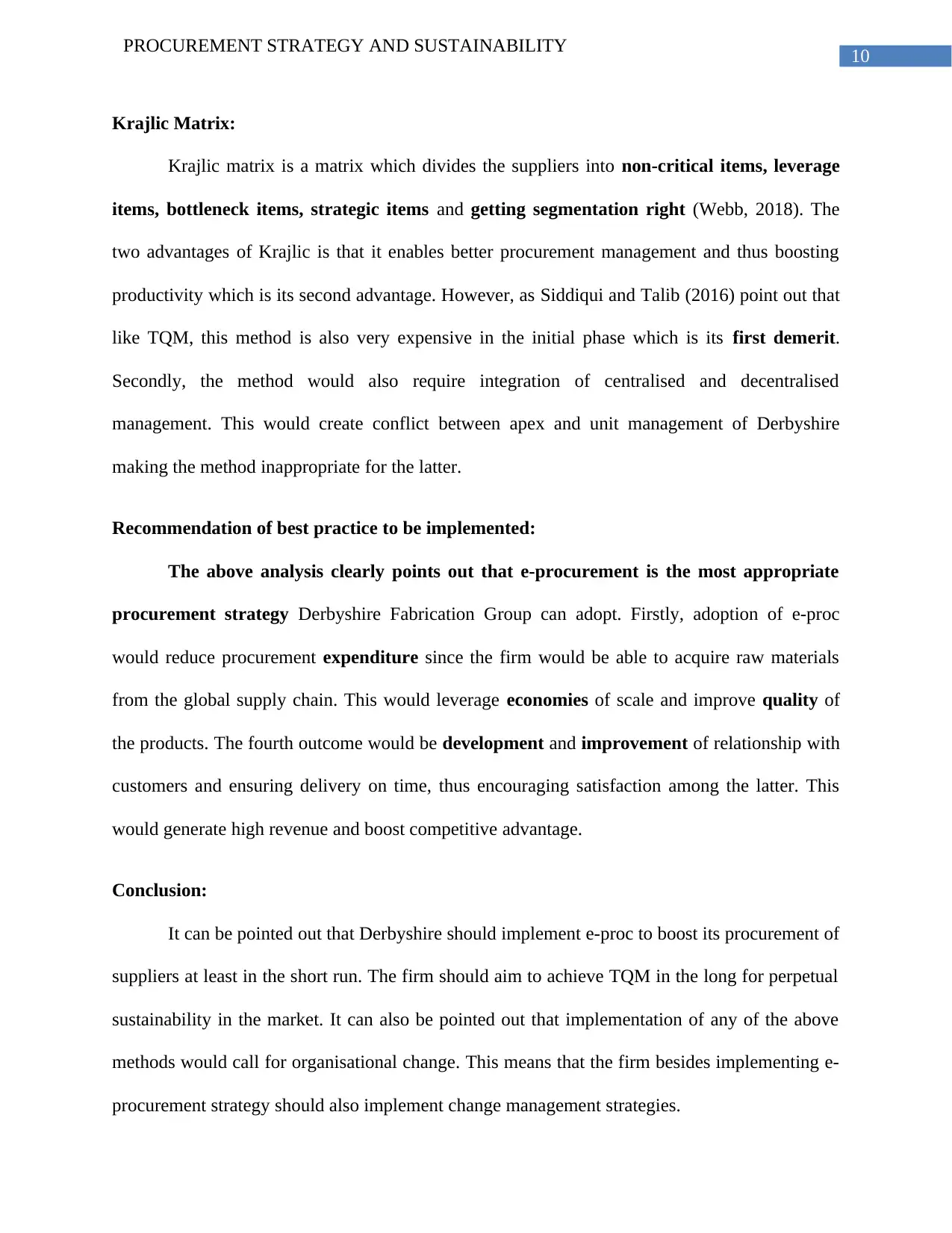
10
PROCUREMENT STRATEGY AND SUSTAINABILITY
Krajlic Matrix:
Krajlic matrix is a matrix which divides the suppliers into non-critical items, leverage
items, bottleneck items, strategic items and getting segmentation right (Webb, 2018). The
two advantages of Krajlic is that it enables better procurement management and thus boosting
productivity which is its second advantage. However, as Siddiqui and Talib (2016) point out that
like TQM, this method is also very expensive in the initial phase which is its first demerit.
Secondly, the method would also require integration of centralised and decentralised
management. This would create conflict between apex and unit management of Derbyshire
making the method inappropriate for the latter.
Recommendation of best practice to be implemented:
The above analysis clearly points out that e-procurement is the most appropriate
procurement strategy Derbyshire Fabrication Group can adopt. Firstly, adoption of e-proc
would reduce procurement expenditure since the firm would be able to acquire raw materials
from the global supply chain. This would leverage economies of scale and improve quality of
the products. The fourth outcome would be development and improvement of relationship with
customers and ensuring delivery on time, thus encouraging satisfaction among the latter. This
would generate high revenue and boost competitive advantage.
Conclusion:
It can be pointed out that Derbyshire should implement e-proc to boost its procurement of
suppliers at least in the short run. The firm should aim to achieve TQM in the long for perpetual
sustainability in the market. It can also be pointed out that implementation of any of the above
methods would call for organisational change. This means that the firm besides implementing e-
procurement strategy should also implement change management strategies.
PROCUREMENT STRATEGY AND SUSTAINABILITY
Krajlic Matrix:
Krajlic matrix is a matrix which divides the suppliers into non-critical items, leverage
items, bottleneck items, strategic items and getting segmentation right (Webb, 2018). The
two advantages of Krajlic is that it enables better procurement management and thus boosting
productivity which is its second advantage. However, as Siddiqui and Talib (2016) point out that
like TQM, this method is also very expensive in the initial phase which is its first demerit.
Secondly, the method would also require integration of centralised and decentralised
management. This would create conflict between apex and unit management of Derbyshire
making the method inappropriate for the latter.
Recommendation of best practice to be implemented:
The above analysis clearly points out that e-procurement is the most appropriate
procurement strategy Derbyshire Fabrication Group can adopt. Firstly, adoption of e-proc
would reduce procurement expenditure since the firm would be able to acquire raw materials
from the global supply chain. This would leverage economies of scale and improve quality of
the products. The fourth outcome would be development and improvement of relationship with
customers and ensuring delivery on time, thus encouraging satisfaction among the latter. This
would generate high revenue and boost competitive advantage.
Conclusion:
It can be pointed out that Derbyshire should implement e-proc to boost its procurement of
suppliers at least in the short run. The firm should aim to achieve TQM in the long for perpetual
sustainability in the market. It can also be pointed out that implementation of any of the above
methods would call for organisational change. This means that the firm besides implementing e-
procurement strategy should also implement change management strategies.
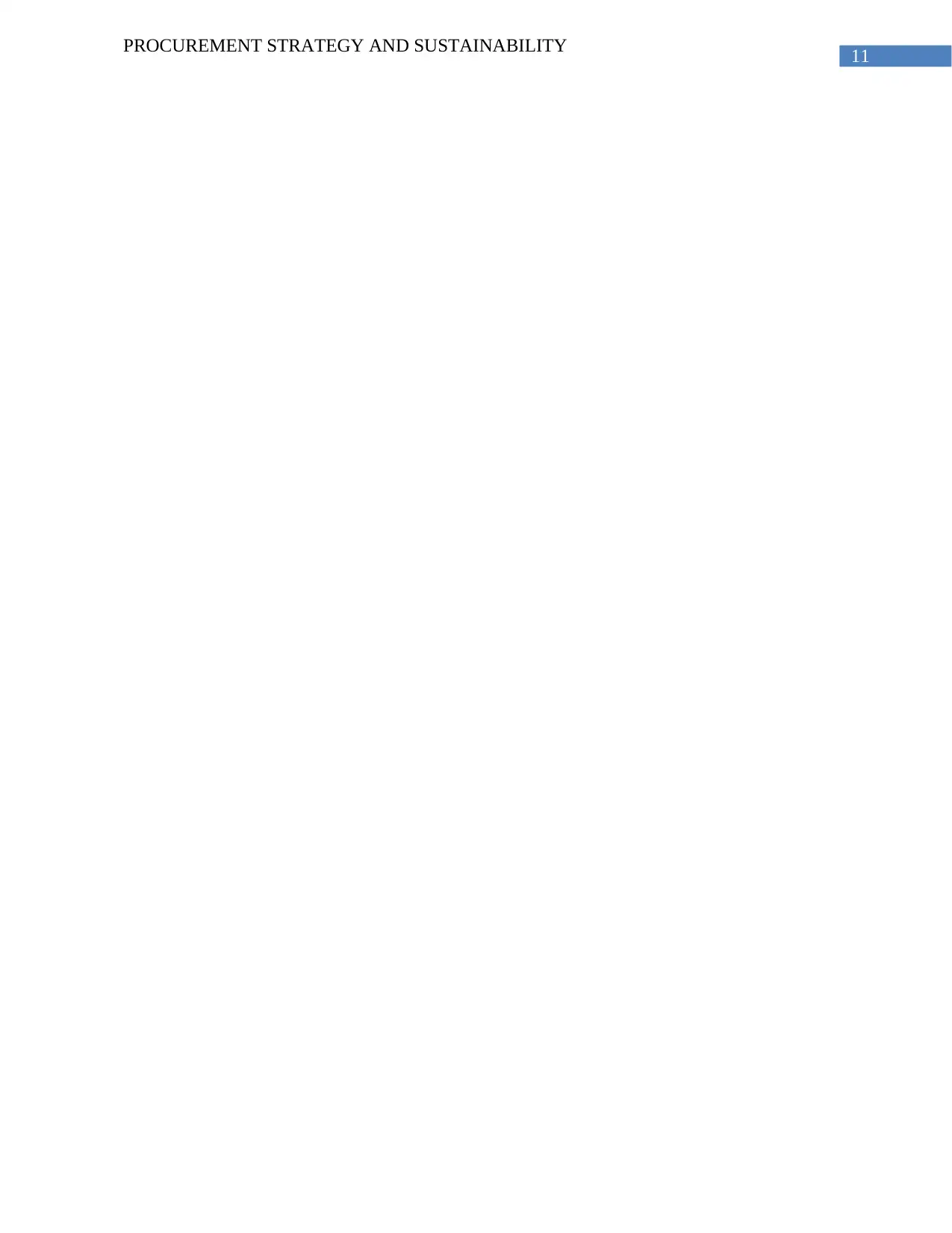
11
PROCUREMENT STRATEGY AND SUSTAINABILITY
PROCUREMENT STRATEGY AND SUSTAINABILITY
⊘ This is a preview!⊘
Do you want full access?
Subscribe today to unlock all pages.

Trusted by 1+ million students worldwide
1 out of 16
Related Documents
Your All-in-One AI-Powered Toolkit for Academic Success.
+13062052269
info@desklib.com
Available 24*7 on WhatsApp / Email
![[object Object]](/_next/static/media/star-bottom.7253800d.svg)
Unlock your academic potential
Copyright © 2020–2025 A2Z Services. All Rights Reserved. Developed and managed by ZUCOL.





